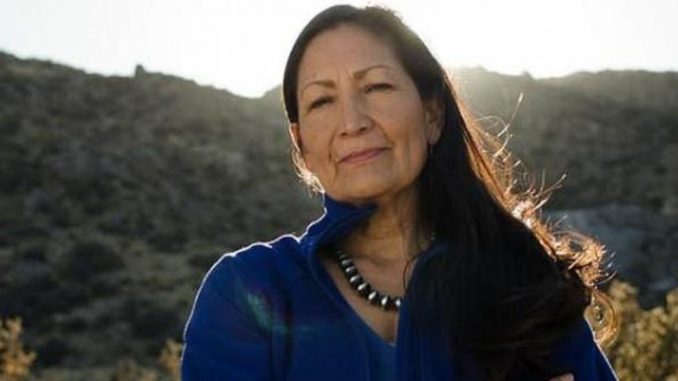
WASHINGTON, DC, March 15, 2021 (ENS) – History was made today as the U.S. Senate voted 51-40 to confirm President Joe Biden’s nominee Congresswoman Debra Haaland as Secretary of the Interior. After she is sworn in, Haaland will be the first Native American to serve as a Cabinet secretary. In 2018, she became one of the first two Native women elected to Congress.
Serving as the U.S. Representative for New Mexico’s 1st congressional district since 2019, Haaland is a member of the Laguna Pueblo, a federally recognized tribe of Native American Pueblo people in west-central New Mexico, near the city of Albuquerque.
Today the Senate voted 51-40 to confirm Haaland as Secretary of the Interior. The confirmation was bi-partisan with four Republicans: Senators Lindsey Graham of South Carolina; Dan Sullivan and Lisa Murkowski of Alaska and Susan Collins of Maine backed Haaland along with the Democrats in attendance. Nine members missed the vote.

In a tweet, Haaland thanked the Senate for confirming her. “As Secretary of @Interior, I look forward to collaborating with all [of] you. I am ready to serve. #BeFierce,” she tweeted. “I will be fierce for all of us,” she has tweeted in the past.
As Secretary of the Interior Haaland will oversee a department that has responsibilities to the country’s 574 federally recognized tribes. She will oversee roughly 640 million acres of public lands, about 28 percent of the 2.27 billion acres of land in the United States.
At her confirmation hearing, Haaland said her top priorities are supporting career employees, promoting clean energy and clean energy jobs, working on broadband internet in Indian Country and encouraging change at the tribal, federal and state levels to prevent violence against Indigenous women who are missing and murdered at 10 times the national average.
She also acknowledged that fossil fuels “will continue to play a major role in America for years to come” and that this needs to be balanced with combating climate change.
Haaland’s opposition to fracking, protest against the Dakota Access pipeline and support for the Green New Deal have made her a favorite among progressives but drawn fear and anger from some Republicans.
Haaland’s position on the extraction and burning of fossil fuels was among the points of contention during her confirmation hearings, and she had to assure Democrat Joe Manchin of West Virginia, a coal-mining state, that she would not shut fossil fuels out of government consideration.
Eventually, she convinced Senator Manchin, who chairs the Senate Committee on Energy and Natural Resources, that as Secretary she would work in a bipartisan manner and would recognize the role of fossil fuels in the nation’s energy mix for the foreseeable future.

On the Senate floor last Thursday, Senator Manchin recounted the two-day hearing before the Committee.
“Her hearing went on for two days,” he said. Every member of the Committee questioned her. Most asked her two rounds of questions, and some asked three rounds. We then asked her 70 pages of questions for the record – nearly 300 questions, many with multiple subparts. The Committee questioned her closely on her beliefs, her opinions, the President’s policies, and what she will do if confirmed.”
In the end, the Committee voted to report her nomination favorably, 11 to 9.
“At her hearing,” Manchin said, “she confirmed that she and the administration recognize that our country will remain dependent on fossil fuels for years to come, and a transition to a cleaner energy future must come through innovation, not elimination.”
“She also affirmed her strong commitment to bipartisanship. She understands the need to work across the aisle to find the bipartisan solutions needed to address the diverse needs of our country and has demonstrated that she can do so effectively.”
“President Biden is in perhaps the most difficult position a modern-day President has been in, bringing us back from the brink after January 6th,” said Senator Manchin, referring to the day that insurrectionists bearing Trump flags stormed the Capital, breaking doors and windows, vandalizing the building and stealing lawmakers’ personal notes and property.
“That day changed me,” Senator Manchin said, “and I feel strongly that with the deep divisions running through our country and the halls of Congress today, we have to have people who have demonstrated they have the temperament and the willingness to reach across the aisle. Congresswoman Haaland has demonstrated that she does and will.”
“As the President works to bind together a nation split by deep political, racial, social, and economic divisions, he is also trying to assemble a Cabinet that reflects the rich diversity of our nation—one that looks like America,” Manchin said. ” Two-hundred-thirty years after [President George] Washington called his first Cabinet meeting, it is long past time to give a Native American woman a seat at the Cabinet table.”
Support for Secretary Haaland is strong across Indian Country. Chase Iron Eyes, lead counsel with the Lakota People’s Law Project, said, “I have spoken multiple times personally with Deb Haaland, and I have heard her knowledgeable perspective on climate issues and other topics of utmost importance to Native populations. She deeply understands the twin priorities of protecting both tribal sovereignty and the health of our planet by transitioning to a clean energy economy.”
“I expect that, as Secretary of the Interior, Deb will protect sacred lands and water, prioritizing and improving the consultation process with tribal nations and asking our consent on matters that deeply affect Indian Country,” Iron Eyes said. “It is no small matter that, for the first time in America’s long and painful history, the executive branch’s nation-to-nation relationships with tribes will be overseen by one of us.”
As Interior Secretary, Haaland would oversee millions of acres of public lands. According to the Congressional Research Service, the federal government manages 640 million acres of the nearly 2.3 billion acres that constitute the United States. The largest land managers for the federal government are the Departments of the Interior, Agriculture, Defense, and Energy.

Within the Department of the Interior, the Bureau of Land Management administers approximately 245 million acres; the National Park Service, 80 million acres; the Fish and Wildlife Service, 150 million acres as part of the Refuge System; and the Bureau of Reclamation manages some 7.8 million acres of land and easements.
The Department of the Interior is the primary federal agency charged with carrying out the United States’ trust responsibility to American Indian and Alaska Native people, maintaining the government-to-government relationship with the 574 federally recognized Indian tribes, and promoting and supporting tribal self-determination.
Interior provides services to 1.9 million American Indian and Alaska Natives that include education, social services, economic development, law enforcement, administration of tribal courts, housing improvement, disaster relief, road maintenance, and natural resource management. Interior also administers programs and laws to protect, conserve and repatriate Indian cultural resources.
“I was very happy,” Marvin Trujillo, tribal secretary for the Pueblo of Laguna, told TV station KRQE, Albuquerque. “Not just only our pueblo, but indigenous nations across the country, just to have great representation and also Congresswoman Haaland has been a great role model to our indigenous communities.”
Haaland also has support from the renewable energy community. Gregory Wetstone, president and CEO of the American Council on Renewable Energy said, “We are delighted to see Deb Haaland named the new Secretary of the Interior. The Interior Department will be instrumental in accelerating the deployment of renewable power, both onshore and offshore. Under her leadership, we can together unlock billions of dollars of private sector investment in clean energy, create tens of thousands of American jobs and tackle the climate crisis.”
Born in Winslow, Arizona, Haaland is a member of the Laguna Pueblo, Indigenous people who have lived on the land that is now the state of New Mexico since the 1200s. Haaland identifies herself as a 35th-generation New Mexican.
Her mother, Mary Toya, a Native American woman, served in the United States Navy. Her father, Major John David “Dutch” Haaland, a Norwegian American born in Minnesota, was an officer in the U.S. Marine Corps and recipient of the Silver Star for his actions in Vietnam; he was buried with full military honors at Arlington National Cemetery in 2005.
As a child in a military family, Haaland moved frequently. She attended 13 public schools across the United States before the family settled in Albuquerque, New Mexico, to be close to other family members.
“Before America’s public lands were America’s public lands, they were Native American lands, and Deb Haaland will be the first Native American to serve in any president’s Cabinet and the first to serve as the secretary of this department, so that’s kind of a wonderful harmony with history,” said Senator Sheldon Whitehouse, a Rhode Island Democrat, in a speech before the vote on Haaland’s confirmation by the U.S. Senate Monday.
The United States has had a Native American vice president, Charles Curtis, who served as President Herbert Hoover’s vice president from 1929 to 1933 but has never before had an Indigenous Cabinet secretary.
Copyright Environment News Service (ENS) 2021. All rights reserved.
© 2021, Environment News Service. All rights reserved. Content may be quoted only with proper attribution and a direct link to the original article. Full reproduction is prohibited.



